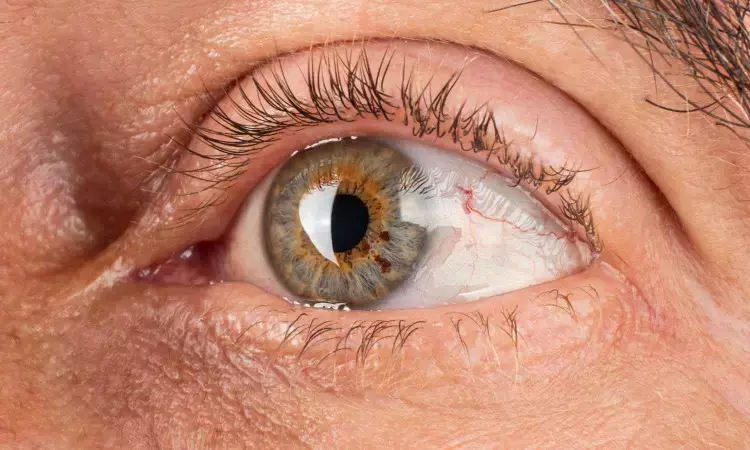- Home
- Medical news & Guidelines
- Anesthesiology
- Cardiology and CTVS
- Critical Care
- Dentistry
- Dermatology
- Diabetes and Endocrinology
- ENT
- Gastroenterology
- Medicine
- Nephrology
- Neurology
- Obstretics-Gynaecology
- Oncology
- Ophthalmology
- Orthopaedics
- Pediatrics-Neonatology
- Psychiatry
- Pulmonology
- Radiology
- Surgery
- Urology
- Laboratory Medicine
- Diet
- Nursing
- Paramedical
- Physiotherapy
- Health news
- Fact Check
- Bone Health Fact Check
- Brain Health Fact Check
- Cancer Related Fact Check
- Child Care Fact Check
- Dental and oral health fact check
- Diabetes and metabolic health fact check
- Diet and Nutrition Fact Check
- Eye and ENT Care Fact Check
- Fitness fact check
- Gut health fact check
- Heart health fact check
- Kidney health fact check
- Medical education fact check
- Men's health fact check
- Respiratory fact check
- Skin and hair care fact check
- Vaccine and Immunization fact check
- Women's health fact check
- AYUSH
- State News
- Andaman and Nicobar Islands
- Andhra Pradesh
- Arunachal Pradesh
- Assam
- Bihar
- Chandigarh
- Chattisgarh
- Dadra and Nagar Haveli
- Daman and Diu
- Delhi
- Goa
- Gujarat
- Haryana
- Himachal Pradesh
- Jammu & Kashmir
- Jharkhand
- Karnataka
- Kerala
- Ladakh
- Lakshadweep
- Madhya Pradesh
- Maharashtra
- Manipur
- Meghalaya
- Mizoram
- Nagaland
- Odisha
- Puducherry
- Punjab
- Rajasthan
- Sikkim
- Tamil Nadu
- Telangana
- Tripura
- Uttar Pradesh
- Uttrakhand
- West Bengal
- Medical Education
- Industry
The Hidden Metabolic Story Behind Vision-Saving Treatment

Macular edema (ME) develops when fluid leaks into the macula, the central part of the retina responsible for sharp vision, typically as a result of retinal vascular leakage in conditions such as age-related macular degeneration (AMD), branch retinal vein occlusion (BRVO), or diabetic retinopathy. Vascular endothelial growth factor (VEGF) fuels abnormal vessel growth and leakage, making anti-VEGF injections the gold standard for restoring vision. However, treatment response is inconsistent, and the risk of side effects remains. While genetics and protein studies have offered partial insights, the small molecules that mirror the eye’s functional state-metabolites-have been less explored. Because of these gaps, researchers set out to map in detail the metabolic shifts triggered by anti-VEGF therapy in ME.
In a study published July 14, 2025, in Eye and Vision, scientists from Wenzhou Medical University decoded the “metabolic footprints” left by anti-VEGF therapy in patients with ME. Using high-resolution metabolomics, they examined eye fluid before and after treatment, revealing distinct chemical landscapes for different disease causes. The work offers the first comprehensive map of how vision-saving injections rewire the eye’s molecular machinery-knowledge that could help doctors predict treatment success and tailor care to each patient’s unique disease profile.
The team collected 120 aqueous humor samples from 60 ME patients-20 each with AMD, BRVO, and diabetic macular edema (DME)-before and about a month after anti-VEGF injections. Untargeted LC–MS/MS analysis showed a clear metabolic shift post-treatment, with 84 metabolites upregulated and 61 downregulated. Many changes involved amino acid and carbohydrate metabolism, while others reflected reductions in lipid-related pathways.
The metabolic patterns differed by disease. AMD-ME showed pronounced changes in amino acid metabolism and suppression of the TCA cycle and purine metabolism, both key to retinal energy balance. BRVO-ME displayed marked lipid metabolism suppression, particularly in fatty acid biosynthesis, alongside shifts in glycerophospholipids. DME revealed a complex web of altered amino acid, lipid, and carbohydrate pathways, including increased cysteine–methionine and sphingolipid metabolism. Across all subtypes, glucose levels rose and homocysteine dropped—two metabolites closely tied to blood vessel growth—hinting at shared therapeutic effects. Together, these findings suggest anti-VEGF therapy reshapes the biochemical environment of the eye in ways that are both common and disease-specific.
“Our research shows that anti-VEGF therapy doesn’t just seal leaky vessels—it rewires the eye’s chemistry in ways we’re only beginning to understand,” said Dr. Meng Zhou, senior author of the study. “By identifying the molecular signatures unique to each type of ME, we open the possibility of predicting who will benefit most from treatment. This could mark a step toward more personalized, efficient care, ensuring that every patient gets the right therapy at the right time.”
The findings offer a roadmap for bringing metabolomics into the clinic. By tracking metabolite changes before and after treatment, clinicians could monitor therapeutic response in real time, detect early signs of resistance, and adjust strategies accordingly. Subtype-specific metabolic profiles could guide tailored treatments—for example, targeting lipid metabolism in BRVO or amino acid pathways in AMD. Beyond eye care, the approach exemplifies how mapping biochemical changes can reveal hidden layers of disease biology, ultimately enabling precision medicine. As tools for metabolic analysis become more accessible, such strategies could transform how retinal diseases are diagnosed, treated, and monitored worldwide.
Reference:
Yan, C., Yi, Q., Ge, L. et al. Metabolomics analysis uncovers metabolic changes and remodeling of anti-VEGF therapy on macular edema. Eye and Vis 12, 28 (2025). https://doi.org/10.1186/s40662-025-00444-2
Dr Kamal Kant Kohli-MBBS, DTCD- a chest specialist with more than 30 years of practice and a flair for writing clinical articles, Dr Kamal Kant Kohli joined Medical Dialogues as a Chief Editor of Medical News. Besides writing articles, as an editor, he proofreads and verifies all the medical content published on Medical Dialogues including those coming from journals, studies,medical conferences,guidelines etc. Email: drkohli@medicaldialogues.in. Contact no. 011-43720751


